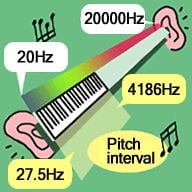Why Can't There Be More Than 88 Keys on a Piano?

The piano that Bartolomeo Cristofori first invented in Italy had only 54 keys. As piano music developed and evolved, the keyboard compass was gradually expanded in response to requests from composers who sought a broader potential for expression.
By the 1890s, today's modern keyboard had become established with 88 keys spanning 7¼ octaves (from 2A to C5; 27.5 Hz to 4,186 Hz*). The human ear can hear sounds in the range from approximately 20 Hz to 20,000 Hz, but the upper limit of frequencies that the human brain can discriminate is at the very most around 4,000 Hz. Even if the compass were to be expanded by increasing the number of keys on the piano, to the human ear, the extra notes at the bass end would become nothing more than a rumbling noise, and the added treble notes would be heard as an unpleasant dissonant noise with no sense of being in a tonal range, and thus, musically, would be almost meaningless. Boesendorfer is making 97-key pianos with nine additional keys in the bass segment of the keyboard (2C to C5). However, the strings for these nine keys in the lowest bass segment are really only there to provide a richer sound when other keys are played by resonating with them. In reality, the extra keys themselves are almost never played directly.
* When A is tuned to 440 Hz. The pitch of the individual keys will vary depending on the tuning method.
Musical Instrument Guide : Piano Contents
Origins
Structure
How to Play
How the Instrument is Made
Choosing an Instrument
Care and Maintenance
Trivia
- The White Keys and Black Keys Were Reversed on Pianos in Mozart's Day
- Did Mozart's Piano Have a Pedal-Board?
- Piano with Automatic Accompaniment System in Beethoven's Day
- The Pianos Beloved by the Great Master, Sviatoslav Richter
- The Optimal Material for Piano Frames Is Also Ideal for Motorcycle Engines
- The Piano Soundboard Is a Board that Also Stops Vibrations
- Why Can't There Be More Than 88 Keys on a Piano?
- Why a Grand Piano Keyboard Feels Heavier Than an Upright Keyboard?
